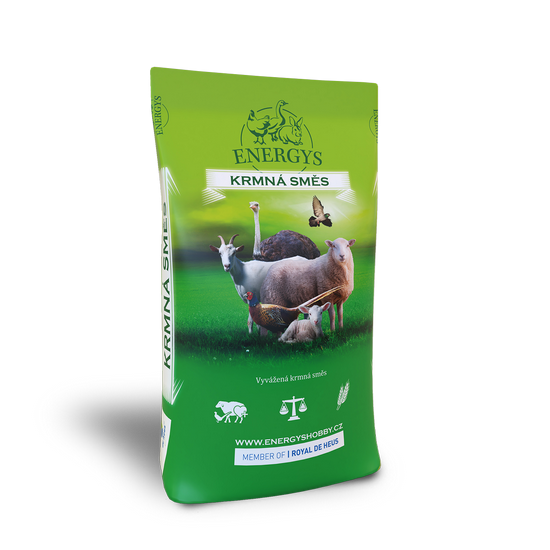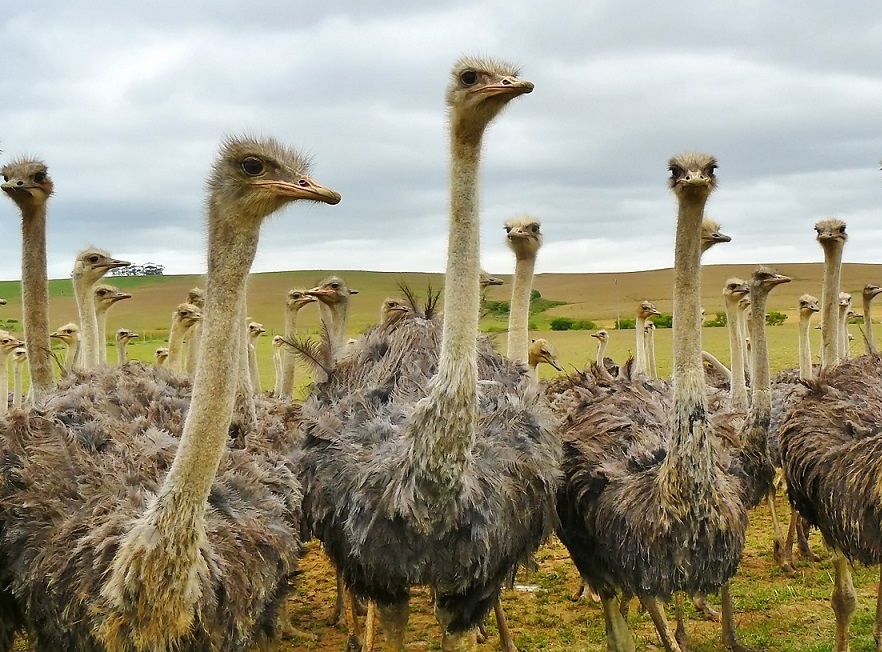Rabbits
Poultry
Laying hens
Quails
Guinea pigs
Pigs
Ostriches
Sheep and goats
Pigeons
Pheasants
Forest animals
Farming Practice
The African ostrich was domesticated during the second half of the previous century in South Africa. Domesticated ostriches have been reared on Czech farms for their meat, leather and feathers since 1993. How egg laying and hatching take place? And what are the most frequent issues affecting ostriches?
Ostrich farming
Ostriches are reared in pairs, in groups, or in so-called triads of one male and two females. The breeding season begins in early spring and lasts until the end of August, and a female ostrich can lay up to 80 eggs in a season.
Egg laying and hatching
So-called repro-pelletsare good for getting the birds ready for the breeding season, start mating and subsequently laying eggs. These pellets contain the best ratios of the required nutrients, including minerals and vitamins. Only a small number of eggs are left in the nest in order to encourage the ostrich hen to keep laying more eggs.
The laid eggs, which are 14 to 18 cm in length, 12 to 15 cm in width and have an average weight of 1.5 kg, are stored in a dark place at a temperature not exceeding 15 °C, for no longer than ten days. After they have been carefully cleaned of any dirt and disinfected, they are placed in an incubator at a temperature of 36.1 °C and 20% humidity for forty days. The eggs are moved to the hatching incubator for the last two days, where they are kept at a slightly lower temperature.
After hatching the chicks are left in the incubator until they are dry and after applying disinfectant to their navels they are moved to the rearing box under an infralamp, under which the temperature ranges between 30°C to 35°C. The temperature is reduced by one to two degrees every day, until a final temperature of 23 degrees is reached. This temperature must be maintained, particularly at night and during cold weather, to prevent the ostrich chicks from getting chilled.
Most frequent problems
Just like in other farm animals, good health is a prerequisite for economic farming. The highest mortality rate is in chicks up to one month of age. According to the results of the State Veterinary Institute in Prague Lysolaje, most of these deaths are caused by multifactorial disorders accompanied by inflammation of the small intestine, respiratory organs, stomach and limbs. Viral and bacterial infections, a number of fungal factors and parasites also contribute to these deaths. There are over ten various intestinal, organ and blood parasites causing protozoan-based infections and at least the same number of predominantly intestinal parasitic worms such as nematodes and helminths.
Sale of products
Meat birds are fattened until they are ten to fourteen months of age, when they reach a weight of around 90 kilograms. The carcass produces meat from just the thighs, which are divided into steak and stewing meat and also into the large and small fillet when dressed.
The economics of ostrich farming can also be improved by sale of the leather, which are in demand from producers of deluxe shoes, handbags, bags, clothing, wallets and other accessories. The unusual structure of the ostrich feathers also means that these can be used in a number of deluxe fashion items.
And lastly, ostrich eggs can also be used in the kitchen and cooked in various ways. The three-millimeter thick shells of ostrich eggs are used either whole for making decorative items, or as fragments, which are used to make jewelry accessories for instance.
Ostrich farming in the Czech Republic
According to the most recent information from the records of the Czech Ostrich Farmers’ Associationthere were 1,597 large flightless birds kept in this country in 2018, 1,328 of these were ostriches, 210 were rhea and 58 emus. However, of the 190 registered breeders, only one fifth of them breed these birds for commercial purposes.
Studánka Ostrich Farm, which was established in 2001 in Židovice by Roudnice nad Labem by Lukáš and Eva Krejny, is a model example of finalization of production of this unusual commodity in this country. The farm complex, where four hundred birds are kept, includes facilities for breeding birds and also for rearing and fattening chicks, as well as a slaughtering facility. However, most of the meat from the annual slaughter production capacity (around 60 per cent) is sold to supermarkets abroad. The farm offers meat to local customers in its own shop. Despite being very similar to beef, and ostrich meat actually rates better than fish in various tests, it is still considered an exotic product in the Czech Republic and interest in this meat remains quite low here.
Related posts
6. April 2022
The farming of the double-fingered ostrich for the production of feathers, skin meat and eggs began in the mid-19th century in africa. Commercial breeding of the largest flightless bird on the planet began in the 1990s.
21. August 2019
The African ostrich was domesticated during the second half of the previous century in South Africa. Domesticated ostriches have been reared on Czech farms for their meat, leather and feathers since 1993. How egg laying and hatching take place? And what are the most frequent issues affecting ostriches?
15. August 2019
Just twenty five years ago no one would have believed that there would be ostrich farms in this country. Which species of large flightless bird are suitable for farming and what should you feed them?
Related products

OSTRICH REPRO
A supplementary feed for ostriches in the laying period. Add an additional 20% of dry fodder or up to 50% of green fodder. Thanks to a high content of chosen substances it supports fertility and higher hatching.

OSTRICH MAXI
A supplementary feeding mix for weaning and fattening ostriches from 6 months to achieval of sexual adulthood or slaughter. Supports fast growth, high meat content and excellent taste. Add a high quality bulky protein feed to the mix.

OSTRICH MINI
A complete feed for the starting phase of weaning and fattening ostriches. Use it from hatching to 6 months of age. After the period given it is advantageous to continue with fattening with the Ostrich MAXI mix. It does not contain coccidosistats.

OSTRICH UNI
A supplementary feeding mix for ostrich breeds in the non hatching period. Cereals and bulky feeds are added to the mix. This feed totally covers the need for vitamins and minerals.

